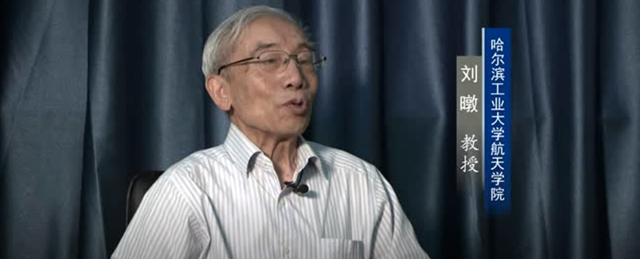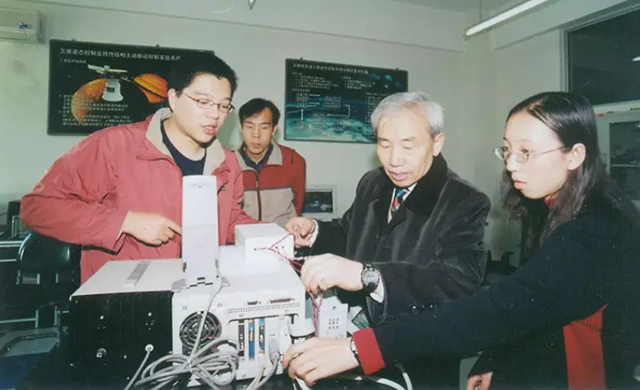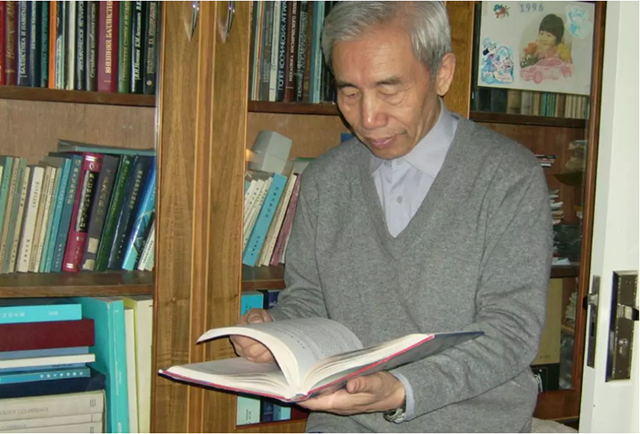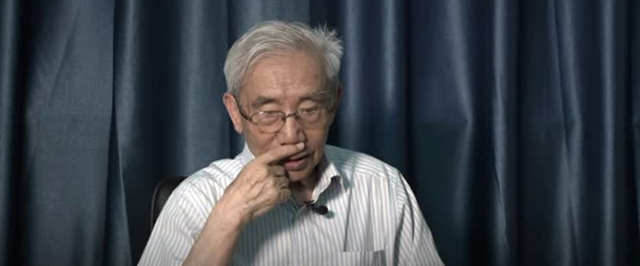Written by: ZHANG Binnan
Translated by: YANG Yue
Edited by: William Mosteller
Date: 11-13

Introduction
Liu Tun, born in October 1932, is a professor and doctoral supervisor of the Department of Aerospace Engineering and Mechanics of the Aerospace College of HIT. He graduated from Harbin Institute of Technology in 1956 and served as the director of the Automatic Flight Dynamics Research Office, the director of the Space Flyer Design Teaching and Research Office, the director of the China Space Science Society, the director of the Gas Lubrication Committee, a member of the Space Motion Control Committee of the China Aerospace Society and Automation Society, and the foreign academician of the Russian Academy of Astronautics. He participated in the Shenzhou V spacecraft design, and was a leader of China's Chang'e lunar landing program sub-project.
Hugo said, The so-called living people are constantly challenging and climbing the destiny of dangerous peaks. Liu Tun is such a person.
In 1949, as a member of a family of railway workers, Liu Tun, who had not graduated from high school, came to Harbin Institute of Technology for preparatory study. Although he did not learn Russian nor finish high school, he quickly skipped from the junior class to the senior class. Two years later, he successfully entered the undergraduate mechanical department, majoring in machine tools and cutters. His excellent academic performance made him a young teacher after graduation.

In 1962, he was transferred to the Fifth Department to enrich the Missile Design Teaching and Research Office. The new major was a new challenge for Liu Tun. He went to Harbin Engineering University for further learning, coupled with self-study, and took a year and a half to master a new major. After returning to HIT, he was appointed the director of the teaching and research office. With the help of Yuan Zhejun and other teachers, he paid attention to teaching materials, laboratory construction, and teacher training, learning while simultaneously teaching. In his own words, "he started the major by gritting his teeth." Although this major was divided and merged after several twists and turns, in retrospect, some of the students trained at that time became generals of the Republic, some were chief engineers of manned space transportation systems, and many became leaders and experts of the major in China----thus, all the hard work and efforts made at that time were worthwhile.

In 1971, Liu Tun participated in the development of the first two-axis gyro drift test rig in China, responsible for the design theory, calculation method, processing technology, and test groping of the gas bearings from start to finish, until he finally handed over the qualified full set of bearings for the first time in China. He also demonstrated and established a design scheme for the horizontal mounting of the outer ring axis and established an effective algorithm for testing 10 drift coefficients in the gyro drift formula. The gyro drift tester has won the first prize of the major science and technology award of the Commission of Science, Technology, and Industry for National Defense and the second prize of the National Scientific Progress Award.
The year 1977 was a landmark year for Liu Tun. This year, HIT resumed the major of Rocket Technology. At that time, less than 30 faculty members, including laboratory technicians and workers, were willing to come back to pursue this major. Therefore, Liu Tun put forward the proposal of establishing three research laboratories: general, strength, and flight mechanics. The first task after the restoration of the laboratory was to develop anti-radar missiles to solve the problem of anti-radar shutdown technology. Liu Tun first proposed a "simple inertial navigation anti-radar shutdown" method in China. As long as there is a radar signal at the initial stage of the missile launch, it can be memorized by computer and hit the target finally. In 1980, the target shooting in-flight test was carried out, which provided a key support for the technology of anti-radar missile guidance in China.

The most challenging task was self-improvement. Liu Tun led the research institute to explore new research directions and identify space technology research that spans dynamics and automatic control. Aiming at elastic (flexible) satellites with large solar panels such as the Dongfanghong III, he created a set of dynamic analysis methods for flexible satellites. He has successively undertaken many research projects such as the dynamics of Zuiyuan II, the liquid sloshing of Dongfanghong III, the blocking and dynamics of the solar canvas of Shenzhou VII, the accompanying small satellite of Shenzhou VII, the overall performance of the Fengyun III meteorological satellite, the suppression of eccentric vibration of Fengyun III, microwave imager, and the small thrust electric rocket Mars probe.
The source of Liu Tun's innovation is his unfading curiosity. He used the nonlinear system characteristic of chaos to explain the reason for the blocking rotation of solar panels of spacecraft, verified the driving system of the solar panel for the Shenzhou spacecraft, verified that the driving system of the solar panel will not block rotation without entering chaos, theoretically ensured the effectiveness of driving of the solar panel of spacecraft, and invented the blocking rotation theory of solar panel and the active vibration suppression method of component force synthesis.
Learning to play was another magic weapon for Liu Tun to keep his creativity going. He is against simply reading and has a wide range of interests and sports abilities. As a student, he was an ice hockey player and captain of the school rowing team, leading the team to win gold and silver. He also used to swim 15 miles along the Songhua River.

Good communicative competence, prominent Russian advantages, and a strong technical foundation make him play an important role in technical exchange and cooperation with Russia. He participated in the "manned space flight" training course, which played a key role in supplementing the domestic space reserve forces. He successfully introduced manned spacecraft, a rendezvous and docking mechanism, an escape tower, a lunar rover prototype, and so on, providing an important reference for China's manned spacecraft, carrier rockets, and lunar rover research.
After more than 60 years of research, Liu Tun says it's hard to get one thing done. There are regrets, but there is also joy. With great persistence and perseverance, Liu Tan has influenced the motherland’s science and technology enterprise.


